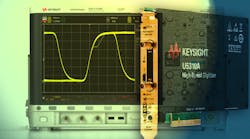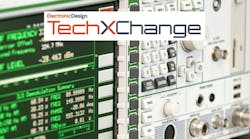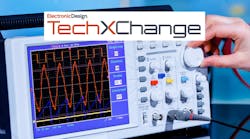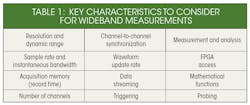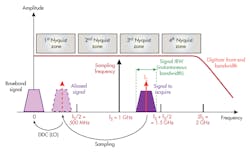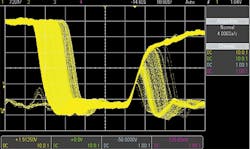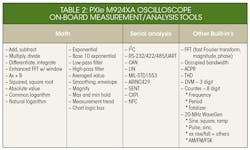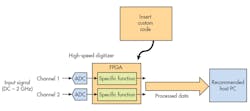What’s the Difference Between Digitizers and Oscilloscopes for Wideband Measurements?
Download this article in PDF format.
We live in a time of significant technology disruption. Emerging applications in wireless communications are trending to wider bandwidths, as well as higher frequencies, denser modulation schemes, multiple channels, and more data to manage. To measure wideband signals, engineers typically use oscilloscopes and digitizers that utilize analog-to-digital converter (ADC) technology for waveform acquisition. In some cases, these instruments are used interchangeably for waveform analysis.
However, despite the many similarities, it’s important to understand that oscilloscopes and digitizers differ significantly, with each optimized for different target applications. For example, oscilloscopes normally come with a large front-panel display and keyboard for quick visualization of time-variant waveforms. Some instrument vendors promote an oscilloscope as a digitizer or a digitizer as an oscilloscope. This can cause confusion. This article describes the key attributes to consider when selecting a digitizer or oscilloscope for your next wideband measurement solution.
Find out more about oscilloscopes
Table 1 lists some of the features to consider as you design your wideband test solution. Let’s walk through a few of the main characteristics:
Resolution and Dynamic Range
Both digitizers and oscilloscopes use ADCs to acquire the waveform data. The ADC samples the input voltages and generates a binary representation of the voltages levels. A good measure of the dynamic range is the effective number of bits (ENOB). ENOB is the effective bit resolution when noise and distortion are considered. It accurately reflects the broadband noise as it appears in frequency- or time-domain measurements.
ENOB = (SINAD – 1.76) / 6.02
SINAD (signal-to-noise and distortion ratio) is a measure of the signal quality. The ADC resolution impacts this, but other factors are involved as well.
Example:
- 8-bit acquisition divides a 10-V p-p input range into 28= 256 levels of 39 mV each.
- 10-bit increase by 4 the number of levels and 16 bit by 256 (152 μV for 10 V p-p)
Oscilloscopes often use 8-bit ADCs for acquisitions over very large bandwidths. The ENOB can be improved by adding different filtering techniques within the scope. For example, a Keysight InfiniiVision oscilloscope with a sample rate of 2.5 Gsamples/s in an 8-bit ADC has a high-resolution mode to achieve better resolution and improve the ENOB to 12 bits with a reduction of bandwidth. Oscilloscope resolution is ideal for visualization of time-domain measurements over very wide bandwidths.
Digitizers often implement 10- to 14-bit ADCs, and offer techniques to get higher resolution over a reduced bandwidth. Digitizers typically provide higher ENOBs, or higher resolution over smaller bandwidths. For applications requiring spectral analysis or those with dynamic signals (large and small voltage components), such as a modulated waveform, a higher ENOB will help to achieve higher resolution and lower noise floor (or better spurious-free dynamic range, SFDR).
Where an 8-bit oscilloscope can provide 45-dB SFDR, a digitizer with more resolution in conjunction with good SFDR will capture finer details during data analysis. For instance, a 10-bit digitizer can achieve 57 dB, and a 12-bit version can achieve 65 dB.
Input Bandwidth and Sample Rate
1. Here, a signal above Nyquist frequency can be represented with a wideband input filter and aliased signal (called undersampling).
It’s important to select a digitizer or oscilloscope that has enough bandwidth to accurately capture the highest frequency component in your signal. The Nyquist sampling theorem states that for a sampling system, the Nyquist frequency (fN) is equal to one-half the sample frequency (fS). Signal energy above the fN will mix with the ADC sample rate and products will fold back on top of the signal of interest at baseband, preventing an accurate acquisition (also called aliasing). Input bandwidth-limiting filters are typically used to ensure there’s no signal energy above the effective Fn. Figure 1 shows how undersampling can be used to acquire signals above fS.
In oscilloscopes, a maximum specified sample-rate fS should be approximately 2.5 to 3 times higher than the real-time bandwidth. This enables a waveform reconstruction filter to accurately reproduce the wave shape of a higher-speed signal with decent resolution.
In digitizers, you may consider selecting a bandwidth greater than half the sample rate (fN). Sometimes, undersampling is used with special input filtering to capture frequencies greater than fS/2. For example, Keysight’s M9203A and M9703B digitizers support 2-GHz bandwidth with an ADC sample clock rate of 1.6 Gsamples/s, allowing for direct downconversion (DDC) using undersampling.
In higher-resolution digitizers, the overall noise added with every increase in bandwidth should be considered. Additional signal conditioning that adds circuitry can affect the SFDR. This is why digitizers usually maintain either ac or dc coupling with limited full-scale range (FSR) capabilities to ensure lowest distortion and largest dynamic range (and best SFDR).
Oscilloscopes can provide multiple FSRs and ac-/dc-coupling selection. An SFDR of 45 dB is adequate for visualization. Larger bandwidths also have less impact because the added noise is not seen with 8-bit resolution.
Acquisition Memory and Streaming
Ensure you have sufficient acquisition memory to capture your most complex signals with an appropriate observation time window. Here, consider the application and how much data needs to be collected. The acquisition memory is usually specified in megasamples or gigasamples in digitizers or Mpoints in oscilloscopes. These define the on-board memory behind each ADC.
Time Span = Acquisition Memory /Sample Rate
Some recording applications require long periods of data acquisition that can’t possibly be stored in the on-board memory. In these cases, off-board streaming is used to acquire the data to be sent to an external storage device for post-processing. Many modular digitizers are ideal for streaming applications, since they connect directly to a high-speed PCIe bus.
2. Traditional, single-shot memory acquisition uses more memory (a) versus segmented-memory acquisitions (b).
Several techniques, including advanced triggering, segmentation, and DDC, can be used to reduce the on-board memory required for acquisitions. Both oscilloscopes and digitizers typically support segmented-memory techniques. With segmented memory, you can use triggering or gating to selectively capture the waveform data and thus reduce the required amount of acquisition memory (Fig. 2).
Digitizers use data-reduction techniques like zero suppress, which only keeps the relevant signal above a given threshold. They also use data packing and rounding to optimize the available memory space. Real-time data-reduction techniques such as DDC are also used. DDC works directly on the ADC data to provide frequency translation and decimation of the data. The block diagram in Figure 3 shows the basic concept.
Complex IQ data is captured, allowing for center frequency translation down to 0 Hz. Filtering and data decimation are then used to remove unwanted frequency components and reduce the size of the required data. DDC is very valuable when analyzing a small slice of spectrum within a wideband acquisition. DDC not only shrinks the needed memory, it also reduces the wideband integrated noise and improves overall signal-to-noise ratio (SNR).
3. DDC is a real-time data-reduction technique that can be used to reduce memory requirements.
Waveform Update Rate
Oscilloscopes have a high on-board waveform update rate that enables viewing of unexpected events and glitches (Fig. 4). Once a random event is identified, you can adjust the scope’s enhanced triggering to capture the event of interest.
Depending on the application, dead time between acquisitions may need to be kept to a minimum. To achieve that, high-speed digitizers leverage techniques such as simultaneous acquisition and readout (or SAR mode).
4. Oscilloscopes provide more than 1,000,000 waveform-per-second update rates for visual identification of unexpected events and glitches.
Triggering
Triggering enables synchronization of signal acquisition. It can range from something as simple as when to start an acquisition, to more complex triggering like triggering on a pattern, burst, or even serial protocol specific triggering. Oscilloscopes typically support many different types of triggering, including edge, pulse width, pattern, rise/fall time, nth edge burst, runt, setup/hold, and more. Some oscilloscopes, like the InfiniiVision, also support serial protocol specific triggering for serial buses like CAN, FlexRay, I2C, LIN, MIL-STD1553, URAT, etc.
Digitizers typically support automated-test-equipment (ATE) types of triggering like edge- and/or channel-level triggering that specify when to start recording the acquisition. Many digitizers support pre- and post-trigger data acquisition, too.
In ATE or larger embedded systems, make sure to consider trigger re-arm time and ensure that all triggers occur simultaneously across all channels/instruments. Digitizer trigger positioning can be precise to a few picoseconds with the included trigger time interpolator (TTI). For example, the M9703B has 15-ps precision. Additional specific trigger detection can be designed in for real-time detection with open FPGA architectures.
Measurements and Analysis
Oscilloscopes are optimized for usability and fast time-to-measurement. They have a large variety of measurement and analysis tools built into the hardware that can be accessed from the instrument front panel in bench instruments, or from a soft front panel when using modular instruments. This makes scopes ideal for a wide range of testing typically done during design or troubleshooting.
Since these measurements are performed in the hardware, the results are acquired quickly for improved time-to-measurement on the bench or in ATE environments. Table 2 shows some of the math, FFT and serial protocol analysis tools available in the InfiniiVision series oscilloscopes.
On the other hand, digitizers rely on the PC-based application software, which does the bulk of the analysis. Some digitizers allow access to the on-board field-programmable gate array (FPGA) so that custom code, filter corrections, or data-reduction schemes can be added into the instrument. Examples include adding math to an output, or including a lookup table to change the output.
In some cases, you may want to add your custom IP into the instrument to perform a special function (Fig. 5). Adding customization in an instrument’s FPGA can extend the instrument’s capabilities, reducing cost and development time, or accelerate measurements. It can also be used to do calculations so that you only need to deal with the data output, reducing the amount of data to manage.
Both oscilloscopes and digitizers may utilize other application-based software and analysis tools to process the acquired signal. Common tools for complex modulation analysis are MathWorks’ software, or Keysight’s 89600 VSA software.
5. Inserting custom code into an instrument’s FPGA can improve time-to-measurement, accelerate tests, or reduce data requirements.
Probing and Input Voltage
Probing can be essential to gaining access to a desired signal. While important, probing typically adds complexity, especially when you consider capacitance loading at higher frequencies, higher voltages, or currents. Active probes should be used for higher-frequency measurements.
Oscilloscopes typically offer a variety of probing options, including passive probes, active probes for voltage and current, high-voltage probes, differential probes, and optical probes. They’re designed to match the scope’s input impedance. With the right probe selection, oscilloscopes can support higher voltage and current inputs.
Digitizers often will not include matched probe solutions, and in many cases, only support a fixed 50-Ω input impedance with a goal to minimize the effect of extra circuitry in the signal path. Also, digitizers are usually embedded in a larger system where signal connection is permanent.
Summary
Oscilloscopes and digitizers both use ADCs for wideband measurements, but each is optimized for different use models and applications.
Oscilloscopes are optimized for visualization over very wide bandwidths. They feature very high waveform update rates for viewing and identifying unknown events or glitches. Advanced triggering enables zeroing in on specific events for further analysis or triggering for high-speed serial bus testing. Various types of oscilloscope probes enable a view of signals at different points within a design, using signal conditioning to accommodate high voltage, current, or frequency. Typical oscilloscope applications include:
- Performing debug and troubleshooting on a design. An oscilloscope enables a view of signal details, with extremely fast waveform updates that reveal waveform details such as glitches and anomalies, and probing ability for targeted areas within the design.
- Capturing infrequent communication errors is critical for serial protocol decoding. It can be achieved using an oscilloscope with hardware-based triggering and serial protocol decode.
- Characterizing and validating digital I/O performance and integrating commercial off-the-shelf (COTS) technologies such as CAN, DDR, DisplayPort, PCIe, NFC, and others.
Wideband digitizers are employed in applications where signal fidelity is important. They typically have high resolution and dynamic range, as well as deep memory for capturing signals to send to a PC using fast multi-lane PCIe buses for post-processing. Sometimes, streaming is utilized in situations where lots of data is being acquired. ATE systems and high-density, multichannel, signal-analysis applications benefit from digitizers with high-resolution ADC technologies. Typical applications include:
- A digitizer, with one to multiple channels, is ideal for monitoring electrical signals to determine physical properties of an event; it’s often used in stimulus response experiments. Signal characteristics can be recorded at instants of time for post-analysis of what happened during the time surrounding the event.
- Multichannel antennas are calibrated by making many cross-channel magnitudes and phase measurements, and then compared to ensure minimal phase difference between channels/elements. Multichannel digitizers are used to quickly acquire cross-channel magnitudes and phase measurements for comparison.
- Multichannel high-speed digitizers are used for multiple-in, multiple-out (MIMO) sounding signal acquisition. Signals are sampled and either processed by an on-board FPGA or I and Q, and then sent to an external storage device for post-processing to create the effective channel-impulse-response (CIR) data in a 5G mmWave MIMO channel-sounding application.
To learn more about the details, advantages, and disadvantages involved when selecting a scope or digitizer for wideband signal acquisitions, check out www.keysight.com/find/wideband-appnotes and/or this webinar.
